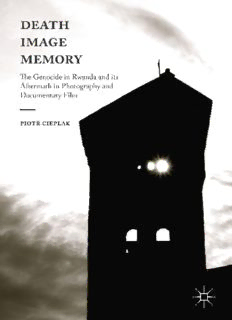
Death, Image, Memory : The Genocide in Rwanda and its Aftermath in Photography and Documentary Film PDF
Preview Death, Image, Memory : The Genocide in Rwanda and its Aftermath in Photography and Documentary Film
Death, Image, Memory PiotrCieplak Death, Image, Memory The Genocide in Rwanda and its Aftermath in Photography and Documentary Film PiotrCieplak BrunelUniversityLondon Uxbridge,UK ISBN978-1-137-57987-4 ISBN978-1-137-57988-1(eBook) DOI10.1057/978-1-137-57988-1 LibraryofCongressControlNumber:2017940239 ©TheEditor(s)(ifapplicable)andTheAuthor(s)2017 Theauthor(s)has/haveassertedtheirright(s)tobeidentifiedastheauthor(s)ofthisworkin accordancewiththeCopyright,DesignsandPatentsAct1988. This work is subject to copyright. All rights are solely and exclusively licensed by the Publisher,whetherthewholeorpartofthematerialisconcerned,specificallytherightsof translation, reprinting, reuse of illustrations, recitation, broadcasting, reproduction on microfilms or in any other physical way, and transmission or information storage and retrieval,electronicadaptation,computersoftware,orbysimilarordissimilarmethodology nowknownorhereafterdeveloped. Theuseofgeneraldescriptivenames,registerednames,trademarks,servicemarks,etc.inthis publicationdoesnotimply,evenintheabsenceofaspecificstatement,thatsuchnamesare exemptfromtherelevantprotectivelawsandregulationsandthereforefreeforgeneraluse. Thepublisher,theauthorsandtheeditorsaresafetoassumethattheadviceandinformation in this book are believed to be true and accurate at the date of publication. Neither the publishernortheauthorsortheeditorsgiveawarranty,expressorimplied,withrespectto thematerialcontainedhereinorforanyerrorsoromissionsthatmayhavebeenmade. Coverimage©PiotrCieplak2016KibuyeChurch Printedonacid-freepaper ThisPalgraveMacmillanimprintispublishedbySpringerNature TheregisteredcompanyisMacmillanPublishersLtd. Theregisteredcompanyaddressis:TheCampus,4CrinanStreet,London,N19XW, UnitedKingdom ForEmma Wilson andBeata Cieplak In memoryof StefanKalota A CKNOWLEDGMENTS I’d like to thank Chris Brown and Emma Wilson for their unwavering support throughout this project. Laura Seymour’s comments and help with thepreparation ofthe manuscript arealso greatlyappreciated. Moreover, I’d like to thank Pam Hirsch, Catherine Grant, Ian James, Libby Saxton, Sam Haddow, Zoe Norridge, Lindiwe Dovey, Phil Clark, Andrew Wallis, Devon Curtis, Ed Saunders, Chris O’Rourke, Matilda Mroz, Beata Cieplak, Lidia Kalota, Geoff King, Julian Petley, Martyna Michalik, Hannah Gibson, Alex Crampton, Amy Digout, Monika Sznajder, Matilda Battersby, Kivu Ruhorahoza, Luc Sung Yu Lun, Jenny Doubt andHelenOyeyemi. Many thanks to Nick Hughes, Patrick Mureithi and Debs Gardner- Patersonforagreeing tobe interviewedforthisproject. In Rwanda, I’d like to thank Eric Kabera, Ayubu Kasasa Mago, Pierre Kayitana, Eugene Safali, Yves Kamuronsi, Claver Irakoze, Jean-Marie Kayishema, Kabwete Charles Mulinda and Naphtal Ahishakiye for their time and expertise. I’d also like to thank the staff at the Rwanda Cinema Centre, the Rwanda Film Festival, IBUKA, the Gisozi Memorial Centre (now Kigali Genocide Memorial), the Genocide Archive, the National University of Rwanda (and its library) and the UN International CriminalTribunalforRwandain Arusha,Tanzania. SomeoftheresearchforthisprojectwasconductedaspartofmyPhD degree,generouslyfundedbytheArtsandHumanitiesResearchCouncil. The research trips that contributed to this book were also supported by the Centre for African Studies at the University of Cambridge, and by vii viii ACKNOWLEDGMENTS BrunelUniversityLondon.TheeditorialteamatPalgraveandthepropo- sal andmanuscript reviewers havealso been tremendouslyhelpful. Lastly, thankyou toMatthew Flacks forallhissupport andpatience. C ONTENTS Introduction 1 Chapter1: Image,Evidence, Memory 25 Chapter2: Images ofAfter:Gilles Peress andSebastião Salgado 55 Chapter3: Images ofBefore: Personal Archives andthe Kigali Genocide Memorial 91 Chapter4: ‘Who FilmedThis?’—Iseta: Behind theRoadblock (2008) 125 Chapter5: ‘IRemember Them’—Keepers of Memory(2004) 159 Conclusion: InDefence of Images? 195 Bibliography 201 Index 219 ix Introduction THE IRRELEVANCE OF IMAGES Inhisaccountofconversationswithsurvivors,TheStrategyofAntelopes: Living in Rwanda After the Genocide (2009), Jean Hatzfeld describes thearrivalofafilmcrewinNyamwiza.Withtheshootsetup,thefilming begins while Hatzfeld and the locals look on. Here’s what they see: ‘a camera mounted on tracks; fake corpses lying in the muck; a loud- speakerblaringdirections;anaked,mud-splatteredboywhopopsinand outofthepapyrusfortakeaftertake’(96–97).It’sjustanotherdayona filmset, only fleetingly disturbed bythecries of some of the technicians ‘who can’t bear visualizing sequences that are too violent’ (97). Once completed,thefilm,RaoulPeck’sSometimes inApril(2005),willtravel totelevision,cinemaandcomputerscreensfar,farawayfromthepapyrus marsh and, joining other movies on the topic, become one of the main points of contact with the Rwandan genocide for audiences around the world.1IntinyNyamwiza,‘thehundredsofonlookerscrouchingonthe grass remain eerily silent, stunned by an enterprise that is to them unthinkable:tomakeamuddykidrehearseandplaythissceneofkilling’ (Hatzfeld, 2009: 97). In The Strategy of Antelopes, the account of the film shoot opens up a conversation between Hatzfeld and Innocent Rwililiza and Berthe Mwanankabandi—both survivors—about what it would mean to convey the experience of the genocide through images. Hatzfeld mentions the lack of photographs of genocidal killings and the abundance of those ©TheAuthor(s)2017 1 P.Cieplak,Death,Image,Memory, DOI10.1057/978-1-137-57988-1_1 2 INTRODUCTION showing the aftermath of the slaughters. Rwililiza responds that he can ‘accept’thepublicdisplayofthelatter‘becausetheyarepicturesfromafter thegenocide’(98).Astothedearthofphotographsofkillings,itis‘most fortunate’.Rwililizasays:‘imagesofkillingsunderway—Icouldnotbear that’. He goes on to observe that the availability of these photographs would ‘pile pain on the suffering of the survivors and be useless besides. Because those pictures would make nothing more explicit to people who did not experience the genocide, and would simply illustrate a dance of death’ (99). Mwanankabandi, while also sceptical about the usefulness of such images, focuses on how impossible it would be for them to convey what death and physical survival felt like. She asks: ‘Who can take a picture of a mama clutching her infant beneath her pagne as she listens to a small band of interahamwe wade past her in the water.’2 And then: Somefugitivesseemedsopanickedanddisheartenedthatyoucouldseeitin theireyes.Whocantakeapictureofthoselooks,andtheoneswegavetothe scatteredclumpsofbodieswhenwecameoutofthemireatsundown?(99) The unbearable thought of the images existing and being viewed, coupled with the doubt about the camera and photographer’s ability to capture anything that could even remotely approach the experience, is summed up eloquently by Rwililiza. He says that ‘the intimate truth of the genocide belongs to those who lived it, and so does the right to withhold this truth’ (100). It is with this warning in mind that I begin this book—very aware that it cannot even approach ‘the intimate truth of the genocide’ as lived through by the survivors and the killers, as experienced by those who didn’t survive. This is partly because of the book’s focus but mostly due to the fact that no amount of reading and analysis can ever stand its ground when confronted with what actually happened and with how the survivors speak about it.3 The testimonies published in Hatzfeld’s earlier volume, Life Laid Bare: The Survivors in Rwanda Speak (2006), offer a glimpse of what it might mean to remember the genocide. Cassius Niyinonsaba—12 years old at the time of the interview—recounts the massacre in the parish church in Nyamata. He talks about the Interahamwe militia cutting everyone sheltered in the church ‘without choosing’; about how ‘people not streaming with
Description: